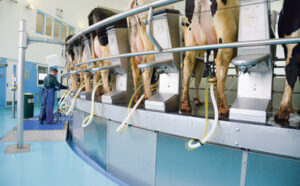Over the past several years, India has witnessed a transformative shift in its agricultural sector, particularly in the realm of livestock production. This evolution is not only responding to the escalating demand for livestock products but is also redefining the socio-economic and environmental landscape of our country. As the population burgeons and dietary habits undergo a shift, the government of India has taken proactive measures to position the country as a global leader in the production and export of high-quality livestock products. This ambitious endeavor is underpinned by the integration of advanced technologies, targeted breeding programs, and holistic management practices. The multifaceted impact of this comprehensive approach extends beyond mere economic considerations, encompassing rural development, improved livelihoods, and enhanced environmental sustainability. At the core of this agricultural renaissance are cutting-edge technologies that are reshaping the dynamics of livestock production in India. Precision farming techniques, genetic enhancements, and the infusion of artificial intelligence into animal husbandry have propelled productivity to unprecedented levels. Real-time health monitoring, data-driven decision-making, and optimized feed formulations are empowering farmers to make informed choices that not only ensure the well-being of their livestock but also enhance overall yield. The advent of these technologies represents a significant leap forward in the modernization of the agricultural sector, marking a departure from traditional practices. The dairy sector has emerged as a key pillar within this paradigm shift. India’s ascent to the top of the world’s milk producers is not merely coincidental but a result of deliberate efforts in scientific breeding practices, improved nutritional regimens, and elevated healthcare standards for dairy animals. This not only meets the burgeoning domestic demand for dairy products but also positions India as a formidable force in the global dairy market, contributing significantly to the national economy. The success of the dairy sector serves as a model for the potential impact of strategic interventions in other segments of livestock production. The commitment of the Indian government to sustainable growth in the livestock sector is exemplified by initiatives such as the National Livestock Mission and Rashtriya Gokul Mission. These programs go beyond rhetoric, providing financial support, comprehensive training programs, and the establishment of robust veterinary infrastructure. This support is crucial in facilitating the seamless transition of farmers towards modern practices and technologies. The government’s role as a catalyst is not only in providing resources but also in creating an enabling environment for the adoption of advanced agricultural practices. The strategies employed for the improvement of livestock production can be delineated into several comprehensive categories, each playing a crucial role in the overall enhancement of the sector:-
The incorporation of state-of-the-art technologies for breeding, healthcare, and farm management is at the forefront of enhancing productivity. From automated feeding systems to IoT-enabled sensors for health monitoring, these technologies are revolutionizing the way farmers engage with their livestock. Rigorous emphasis on selective breeding for desired traits, such as disease resistance and increased yield, is reshaping the genetic landscape of livestock. This strategic breeding approach is not only improving the quality of the livestock but also ensuring the sustainability of the sector. Ensuring proper nutrition for livestock is pivotal in enhancing growth rates and reproductive efficiency. The optimization of feed formulations, taking into account the nutritional requirements of different breeds and life stages, is a key component in this comprehensive approach. The implementation of effective disease prevention and control measures is crucial in reducing mortality rates and elevating overall herd health. Vaccination programs, biosecurity measures, and early detection systems are integral components of this strategy.
“As India strides towards a future characterized by agricultural advancement, the revolution in livestock production stands out as a pivotal contributor to this vision. The integration of advanced technologies, targeted breeding programs, and holistic management practices is not merely a response to immediate demands but a strategic move to position India as a global leader in the livestock industry.”
Beyond the individual animal level, promoting sustainable and efficient farm management practices contributes to environmental sustainability. Proper waste management, water conservation, and energy-efficient practices are vital for ensuring the long-term viability of livestock farming. Empowering farmers through comprehensive training and education on modern farming practices and technologies is indispensable for successful implementation. Training programs cover a spectrum of topics, including the use of technology, best practices in animal husbandry, and sustainable farming methods. Improving access to markets and ensuring fair pricing serve as motivational factors for farmers to invest in and adopt superior livestock management practices. The integration of farmers into value chains and the assurance of fair returns incentivize the adoption of modern techniques. Investment in cutting-edge research for innovative solutions, such as biosecurity measures and improved breeds, is the driving force behind long-term advancements. Research institutions and collaborations between academia and the industry play a pivotal role in pushing the boundaries of knowledge in livestock science. Supportive government policies that promote sustainable and modern livestock farming practices create an enabling environment for continual improvement. This includes regulatory frameworks, subsidies for adopting new technologies, and incentives for environmentally friendly practices. In synergy, these comprehensive strategies form a holistic approach that not only addresses immediate challenges but also fosters an environment for sustained growth. The interconnectedness of these strategies reflects a recognition of the complexity of the livestock production system and the need for a multifaceted approach. As India propels towards becoming a global powerhouse in livestock production, the transformative impact extends beyond economic considerations. It resonates across rural communities, contributing to improved livelihoods, strengthened rural economies, and a more resilient and sustainable agricultural future. Revolutionizing livestock production in India requires a multi-faceted approach that amalgamates technological innovations, policy reforms, and community engagement. Precision Livestock Farming, artificial intelligence, and biotechnology emerge as the linchpins for enhancing productivity and sustainability. Simultaneously, government policies must incentivize sustainable practices, strengthen veterinary services, and promote integrated land use planning. Community engagement, facilitated through farmer education, cooperatives, and digital connectivity, is essential for ensuring widespread adoption and success. This comprehensive approach, grounded in a deep understanding of the interplay between technological, policy, and community-driven factors, holds the potential to transform the livestock sector, contribute significantly to agricultural advancement, and improve the overall well-being of the nation. As India strides towards a future characterized by agricultural advancement, the revolution in livestock production stands out as a pivotal contributor to this vision. The integration of advanced technologies, targeted breeding programs, and holistic management practices is not merely a response to immediate demands but a strategic move to position India as a global leader in the livestock industry. The success of this comprehensive approach is not limited to economic metrics alone. It reverberates across rural landscapes, bringing about improved livelihoods, sustainable agricultural practices, and enhanced environmental stewardship. The journey towards a prosperous agricultural future is underway, and the comprehensive transformation of livestock production is steering India in the right direction.
(Author is BVSC Student at Andhra Pradesh College. The views, opinions and conclusions expressed in this article are those of the author and aren’t necessarily in accord with the views of “Kashmir Horizon”.)
[email protected]



